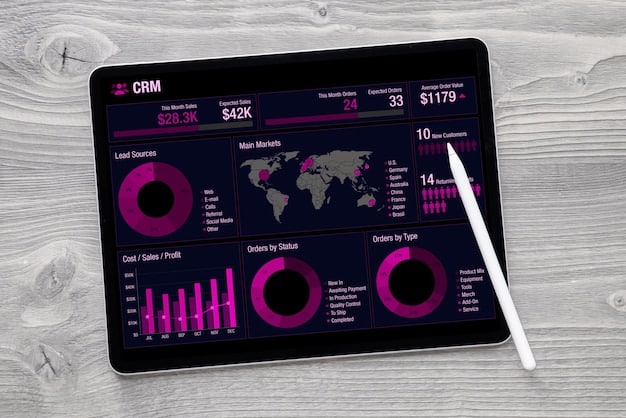Building MVP for US Tech Startups in 90 Days: A Guide

Building a Minimum Viable Product (MVP) for US Tech Startups in 90 Days is achievable by prioritizing core functionality, securing early user feedback, and iteratively developing to validate market assumptions and pave the way for scalable growth.
For US tech startups, the race to market can feel daunting, but the concept of a Minimum Viable Product (MVP) offers a tangible pathway to rapid validation and growth. It’s not about cutting corners, but about intelligent focus: delivering core value swiftly to learn from real users. This guide explores how a lean-first approach, coupled with strategic planning and agile execution, can bring your MVP to life within a challenging yet rewarding 90-day window.
Defining Your Minimum Viable Product (MVP)
Developing a strong MVP begins with a crystal-clear understanding of what “minimum viable” truly means for your specific product and target market. It’s tempting to cram in every conceivable feature, but this often leads to delays, increased costs, and a product that misses the mark on solving a core problem. Instead, the focus must be on identifying the absolute essential functionalities that address a critical pain point for your early adopters. This initial scope definition is paramount for ensuring a tight 90-day development cycle.
Before any line of code is written, it’s crucial to immerse yourself in market research. Who are your potential users? What specific problems do they face that your product proposes to solve? By conducting interviews, surveys, and analyzing existing market solutions, you can pinpoint the core problem and begin to delineate the most critical features required to address it. This isn’t just about what you *think* users need, but what they genuinely *express* as their pressing challenges. Without this foundational understanding, even the most innovative solution may fail to resonate. This early investment in user discovery prevents building features that ultimately add complexity without corresponding value.
Identifying the Core Problem and Solution
The heart of any successful MVP lies in its ability to elegantly solve a singular, significant problem. This requires a deep dive into user needs and market gaps. By focusing on one primary issue, a startup can channel limited resources towards developing a highly effective, albeit limited, solution. This ensures that the MVP provides immediate and undeniable value, making it attractive to initial users. Without this singular focus, the product risks becoming a generalist tool that excels at nothing.
- 🔬 Market Research: Understand your target audience’s pain points.
- 🎯 Problem Validation: Confirm the problem is widespread and worth solving.
- 💡 Core Solution: Define the simplest way to address the identified problem.
- 📊 Value Proposition: Articulate the unique benefit your MVP offers.
Stripping Down to Essential Features
The concept of “minimum” in MVP is often misunderstood. It doesn’t imply a shoddy or incomplete product. Rather, it means identifying the absolute fewest features necessary to validate your core hypothesis and deliver true value. This process often involves uncomfortable decisions, such as deferring desirable but non-essential functionalities. Each proposed feature should be scrutinized with a question: Is this feature absolutely necessary to solve the core problem for our initial users? If the answer is no, it should be put aside for future iterations. This disciplined approach is what allows for a rapid development timeline and avoids feature bloat, which can plague early-stage startups.
The objective is to create a functional (not perfect) product that attracts early adopters, generates feedback, and collects data to inform subsequent development cycles. This iterative process is a cornerstone of agile methodologies, which are crucial for quick MVP launches. By launching light, you gain the agility to pivot or refine based on real-world usage, rather than spending months or years building something that might not entirely fit the market’s needs. This philosophy underscores the commitment to learning and adapting.
Strategic Planning for 90-Day Execution
The compressed timeline of 90 days for MVP development demands meticulous planning and unwavering discipline. Without a robust strategy, even the most innovative ideas can falter under the pressure of tight deadlines and limited resources. This phase is about translating your well-defined MVP concept into a concrete, executable roadmap, prioritizing tasks, allocating resources efficiently, and establishing clear metrics for success.
The initial step in strategic planning involves setting realistic and measurable goals. What specific outcomes do you aim to achieve with this 90-day MVP? Is it to validate a market hypothesis, gain a certain number of early users, or attract initial funding? These objectives will guide every decision throughout the development cycle. Once goals are clear, breaking down the entire project into smaller, manageable sprints becomes essential. Agile methodologies, such as Scrum or Kanban, are particularly effective here, allowing teams to focus on short-term deliverables and adapt to challenges as they arise.

Assembling Your Core Team
A small, dedicated, and cross-functional team is often the most effective for rapid MVP development. Each member should bring diverse skills—from product management and design to front-end and back-end development—and a shared understanding of the MVP’s vision. Clearly defined roles and responsibilities minimize bottlenecks and ensure everyone is aligned with the common goal of launching within 90 days. Communication within such a team must be frequent, transparent, and direct, fostering a culture of accountability and shared problem-solving. This tight collaboration is a significant differentiator.
Technology Stack and Tools Selection
Choosing the right technology stack is a critical decision that influences development speed, scalability, and future flexibility. For an MVP, preference should be given to familiar, mature, and rapidly deployable technologies that minimize learning curves and maximize efficiency. Cloud-based platforms (like AWS, Azure, GCP) can accelerate infrastructure setup, while well-documented frameworks and libraries can expedite development. The focus should be on practical solutions that get the product out the door, rather than experimenting with bleeding-edge technologies that could introduce unforeseen complexities. Simplicity and speed are key motivators here.
Effective project management tools are indispensable for tracking progress, managing tasks, and facilitating collaboration within the 90-day sprint. Tools like Jira, Trello, or Asana can help visualize workflows, assign tasks, set deadlines, and monitor team performance. Regular stand-up meetings (daily scrums) are vital for maintaining momentum, identifying roadblocks early, and ensuring the team remains in sync. This structured approach to communication and task management is what enables a tight timeline.
Agile Development and Iteration Cycles
The agile methodology is not merely a buzzword; it’s a fundamental principle for success when aiming to launch an MVP within a 90-day timeframe. It emphasizes iterative development, constant feedback loops, and adaptability over rigid, long-term planning. For US tech startups, this means moving away from traditional waterfall models and embracing a more fluid, responsive approach that accommodates change and continuous improvement.
Implementing agile practices involves breaking down the entire MVP development into short, focused iterations, often called sprints, typically lasting one to two weeks. Each sprint has its own set of specific deliverables, contributing to the overall MVP goal. This allows the team to tackle complex problems in smaller, more manageable chunks, making the process less overwhelming and providing regular opportunities to review progress and make necessary adjustments. The core of agile is its emphasis on flexibility.
Sprint Planning and Execution
At the beginning of each sprint, the team collaborates to define the specific features and tasks to be completed within that cycle. This involves creating a detailed backlog of prioritized tasks, ensuring that the most critical functionalities are addressed first. During the sprint, daily stand-up meetings keep everyone informed of progress, challenges, and upcoming tasks. Obstacles are identified and addressed quickly, preventing significant delays. This continuous monitoring is paramount.
The development process within each sprint should focus on delivering working software, even if it’s just a small increment of functionality. This “done is better than perfect” mentality is crucial for an MVP. By having tangible outputs at the end of each sprint, the team can demonstrate progress, gather early feedback, and maintain momentum. This also means that testing and quality assurance are integrated into every stage of development, not just as a final phase.
Incorporating User Feedback Early and Often
One of the most powerful aspects of agile development for an MVP is the emphasis on incorporating user feedback from the earliest stages. Once a basic, functional version of a feature is complete, it should be put into the hands of real users as quickly as possible. This isn’t about launching to the public, but about conducting targeted user testing with a small group of ideal early adopters. Their insights are invaluable.
Feedback can come through various channels, from direct interviews and usability testing sessions to analytics data on how users interact with the product. This feedback loop is essential for validating assumptions, identifying pain points that may not have been obvious internally, and making informed decisions about feature prioritization for subsequent sprints. Iteration based on real user behavior prevents the team from building features nobody wants.
Prioritizing and Scoping Continuously
Given the tight 90-day deadline, continuous prioritization and scope management are non-negotiable. As new information emerges—whether from user feedback, market analysis, or technical challenges—the team must be prepared to adjust its plans. This might mean deferring certain features to a later roadmap, simplifying existing ones, or even pivoting the direction slightly if initial assumptions prove incorrect.
This dynamic flexibility ensures that the MVP remains focused on delivering the most critical value. The Pareto principle (80/20 rule) often applies here: focus on the 20% of features that will deliver 80% of the value. Rigidity is an enemy during MVP development; adaptability is a superpower.
Marketing and Launch Strategies for Your MVP
Launching your MVP is not merely a technical event; it’s a strategic marketing moment that requires careful planning and execution. Even the most innovative MVP won’t gain traction if potential users are unaware of its existence or its value. For US tech startups, effectively communicating your product’s core offering and reaching your target audience within the 90-day window is as crucial as the development itself.
The marketing strategy for an MVP differs significantly from that of a fully-fledged product. The goal isn’t mass market penetration yet, but rather attracting a specific cohort of early adopters who are likely to provide valuable feedback and become advocates. This often means focusing on niche communities, industry influencers, and channels where your target audience congregates. Quality over quantity is the mantra for initial acquisition.
Identifying Early Adopters
Before launching, have a clear profile of your ideal early adopter. These are the individuals or businesses who keenly feel the problem your MVP solves and are open to trying new solutions, even if they are still somewhat raw. They are often tech-savvy, open to giving feedback, and willing to overlook minor imperfections for the sake of solving a real problem. Engaging with these communities through social media groups, industry forums, or specialized online platforms can be highly effective.
Crafting Your Messaging and Story
Your MVP’s story should be compelling, concise, and clearly articulate the core problem it solves and the unique value it offers. Avoid jargon and focus on benefits, not just features. For US audiences, authenticity and a clear value proposition resonate strongly. A strong narrative helps transform your product from a mere tool into a solution that truly understands and addresses user needs. This narrative is paramount for early adoption.
- 🗣️ Clear Problem Statement: Define the pain point your MVP addresses.
- ✨ Unique Value Proposition: Highlight what makes your solution different.
- 🚀 Benefit-Oriented: Focus on what users gain, not just what the product does.
- 💬 Authentic Voice: Speak directly to your audience in a relatable tone.
Pre-Launch Buzz and Landing Page
Even before your MVP is technically “launched,” building anticipation can be highly beneficial. A simple landing page capturing email addresses of interested users is a powerful tool. This page should succinctly explain your product, highlight its unique selling points, and offer an incentive for signing up (e.g., early access, exclusive content). This list becomes your initial pool of beta testers and early users, ensuring a warm reception upon launch.
Leveraging Digital Channels for Reach
For a 90-day timeline, digital marketing channels offer the quickest and most cost-effective routes to market. This could include targeted social media campaigns (e.g., LinkedIn for B2B, Twitter/Instagram for B2C), content marketing (blog posts, short videos), and strategic partnerships with influencers or complementary businesses. The key is to be present where your early adopters are, providing value before asking for anything in return.
Launch strategies might involve a soft launch to a selected group for a final round of feedback, followed by a public launch through product directories (e.g., Product Hunt, BetaList), industry publications, and your established email list. The goal is to generate initial traction, gather data, and prepare for the next phase of iteration and growth.
Measuring Success and Iterating for Growth
Launching your MVP within 90 days is merely the first significant milestone; the real work of validation and growth begins immediately after. Success isn’t defined by the launch itself, but by what you learn from it and how you adapt your product based on real-world usage. This requires a robust framework for measuring performance, analyzing data, and continuously iterating your product to meet evolving user needs and market demands.
The concept of “build-measure-learn” from the Lean Startup methodology is highly applicable here. You’ve built your MVP; now you must rigorously measure its performance and learn from the data to inform your next steps. This iterative cycle is critical for transforming an MVP into a viable, scalable product that truly resonates with its target market. Without this disciplined approach to data, future development risks being based on assumptions rather than evidence.
Defining Key Performance Indicators (KPIs)
Before launching, establish clear KPIs that align with your MVP’s initial goals. These might include metrics like user acquisition rate, active user engagement (daily/weekly active users), feature usage, session duration, conversion rates (if applicable), and most importantly, user retention. For a US tech startup, understanding these numbers provides objective insights into whether your MVP is solving the intended problem effectively and retaining its user base.
Tools like Google Analytics, Mixpanel, Amplitude, or even simple in-app feedback mechanisms can help track these KPIs. It’s not just about collecting data, but about understanding what the data tells you about user behavior and product performance. Are users completing the core flow? Where are they dropping off? Which features are being used most, and which are ignored?
Collecting and Analyzing User Feedback
Quantitative data from KPIs needs to be complemented by qualitative insights from direct user feedback. Set up channels for users to provide input, such as in-app surveys, feedback buttons, direct email, or even community forums. Actively solicit opinions through user interviews and usability testing sessions. Pay close attention to both explicit feedback (what users say) and implicit feedback (how they behave).
Analyzing this feedback involves looking for patterns, identifying common pain points, and prioritizing improvements based on impact and feasibility. It’s crucial to distinguish between noise and genuine insights. Not every feature request should be acted upon, but recurring themes or critical usability issues demand attention. US tech startups thrive on rapid feedback loops.
Prioritizing the Product Roadmap
Based on the insights gained from KPIs and user feedback, your product roadmap should be a living document that continually adapts. Features that prove valuable should be enhanced, while those that don’t resonate should be reconsidered or removed. New features should be added based on validated needs, not just perceived ones. This continuous prioritization ensures that development resources are always directed towards maximizing value.
The journey from MVP to a fully mature product is a series of informed iterations. Each cycle of building, measuring, and learning refines the product, bringing it closer to a perfect market fit. This disciplined, data-driven approach positions US tech startups for sustainable growth and long-term success in a competitive landscape.
Common Pitfalls and How to Avoid Them
Even with the best intentions and meticulous planning, building and launching an MVP within 90 days can be fraught with challenges. Understanding common pitfalls and proactively addressing them is crucial for staying on track and achieving your goals. For US tech startups operating under tight deadlines, awareness of these traps can make the difference between a successful launch and a derailed project.
Many startups fall into the trap of over-scoping their MVP. The desire to impress or to encompass every possible use case can lead to feature bloat, pushing the 90-day deadline well out of reach. Another common issue is underestimating the time required for testing and bug fixing, which are critical components of a viable product, even a minimum one. Ignoring user feedback or misinterpreting data can also lead to building features that don’t truly solve user needs.
Scope Creep: The Feature Trap
The most pervasive pitfall is “scope creep,” where additional features are continually added to the MVP, extending development time and budget. The antidote is rigorous adherence to the initial MVP definition and core problem statement. Every new feature request must be critically evaluated against the question: “Is this absolutely essential for our MVP to validate its core hypothesis and provide minimum value?” If not, it belongs in the next iteration. A “parking lot” for future features can help manage these desires without derailing the current project.
Ignoring User Feedback
An MVP’s primary purpose is to learn from users. Failing to actively collect, analyze, and act upon user feedback negates the entire “learn” phase of the build-measure-learn loop. This can lead to building a product that no one wants or solving a problem that doesn’t exist. Establish clear feedback channels and dedicate time to reviewing insights, even if some feedback is difficult to hear. For US tech startups, user-centricity is often the core of innovation.
Lack of Clear Communication and Alignment
In a fast-paced 90-day project, miscommunication within the team or between the team and stakeholders can lead to misunderstandings, duplicated efforts, and missed deadlines. Regular, transparent communication is vital. Daily stand-up meetings, clear documentation, and a shared understanding of priorities ensure everyone is aligned and working towards the same goal. When issues arise, they should be communicated immediately and addressed collaboratively.
Underestimating Time for Testing and QA
Launching a buggy or unreliable MVP can be more damaging than delaying the launch. Users expect a certain level of quality, even from a minimum viable product. Underestimating the time and resources needed for thorough testing, quality assurance, and bug fixing is a common mistake. Integrate testing throughout the development sprints, rather than leaving it all to the end. Automated testing can help accelerate this process significantly.
Building for Perfection, Not Validation
The MVP is about validating your core hypothesis and learning, not delivering a polished, perfect product with every bell and whistle. Striving for perfection at the MVP stage wastes valuable time and resources that could be better spent on iteration based on real user data. Embrace the “good enough” philosophy for the first release, focusing on functionality and value over aesthetics or comprehensive features. The goal is to learn, not to launch a finished product.

| Key Point | Brief Description |
|---|---|
| 🎯 Focus on Core Problem | Identify and solve one critical user pain point with essential features. |
| ⏱️ Agile Execution | Implement short sprints and continuous iteration to meet deadlines. |
| 👂 User Feedback Loop | Collect and act on early user insights to validate and refine the product. |
| 🚫 Avoid Scope Creep | Resist adding non-essential features to stay within the 90-day timeline. |
Frequently Asked Questions About Building an MVP in 90 Days
An MVP is the version of a new product that allows a team to collect the maximum amount of validated learning about customers with the least amount of effort. It contains only the core features necessary to solve a primary problem, attract early adopters, and receive critical feedback for future iterations.
A 90-day timeline creates urgency and forces startups to ruthlessly prioritize core functionalities. It accelerates market validation, reduces development costs, and allows for quicker iterations based on real user feedback. This speed is crucial for US tech startups in a rapidly evolving market, ensuring quick adaptation.
Identify the single most critical problem your product solves for your target users. All features included in the MVP must directly contribute to solving this core problem. Eliminate any features that are “nice-to-have” but not essential for the initial value proposition or validation.
A small, cross-functional team with diverse skills (product, design, development) and a strong commitment to agile principles is ideal. Clear communication, shared goals, and a focus on speed over perfection are crucial for a 90-day turnaround. Experience with lean methodologies is a significant plus.
The launch is just the beginning. After launching your MVP, the focus shifts to collecting user feedback, analyzing performance metrics (KPIs), and continuously iterating the product based on validated learnings. This “build, measure, learn” cycle guides future development and drives sustained growth.
Conclusion
Building a Minimum Viable Product (MVP) within 90 days for US tech startups is an ambitious, yet entirely achievable, goal that demands strategic planning, disciplined execution, and a relentless focus on core value. By meticulously defining the problem, assembling a lean team, embracing agile methodologies, and fostering a culture of continuous feedback, startups can significantly de-risk their ventures and accelerate their path to market validation. The rapid development and launch of an MVP is not about perfection, but about learning and adapting swiftly, positioning your startup for informed growth in a competitive landscape.





